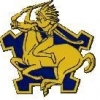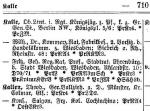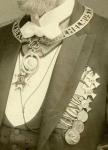-
Posts
629 -
Joined
-
Last visited
-
Days Won
3
Content Type
Profiles
Forums
Blogs
Gallery
Events
Store
Everything posted by W McSwiggan
-
BELOW: His entry in the Deutscher Ordens-Almanach 1908/09 (the last edition ever printed, alas) repeats these awards and his address. But how about more biographical detail? Welllll…. Oddly enough, TWO of his sons AND a daughter in law (born 28.02. 1896) are listed in the 1935 edition of “Wer Ist’s?”— …thus producing Data From beyond The Grave. Unfortunately from the sources I have at hand, am unable to determine when Dr. Kalle’s EH2b was awarded, since the Hof- und-Staats Handbücher did not always show awards. He himself would doubtless have had entries in pre-Great War editions of “Wer Ist’s?” and You Who Are Wise In The Ways Of Google may no doubt find much more on him from this internet-thingum. My thanks to the photo’s Traveling Museum owner for allowing this to be shared with you all, and to my Known Associates In Research for adding data to this lonely nameless photos. Pharaohs spent fortunes to be immortal— we of the Research Priesthood do this without temple offerings—MEMORY IS RESTORED !!! Thanks to the Traveling Museum member who owns this for bravely visiting The Island one last time before Ice-In to allow you all to share this, and WEM for posting since I am not online. Rick Research
-
The combination certainly suggests someone like a medical doctor, doesn’t it? But to verify this, we must delve deep into the Research Mines—and HOPE that he was both a) alive and b) vain enough to have paid to list himself in the vanity press 1908/09 German Orders Almanac. Hours pass. But HE isn’t going anywhere, is he? MANY hours. I do not know the final total of Wilhelm Orders awarded, but from this elaborate (and extremely peculiar) award’s creation in 1896 to the beginning of 1913, only 63 had been bestowed—21 of those to women! Of those ladies, 5 were Royals. Recipients were widows with literally no other award and State Ministers—quite an eclectic group… but a very SMALL one! Gerd Scharfenberg’s 1996 Deutsche Soldaten Jahrbuch article “Der Königlich Preußische Wilhelm-Orden zum 100. Jahrestag seiner Stiftung” gives 2 more awards to 28 August 1913 for 65 to that date. The KO4mrKw6s—to give its official Rank List “abbreviation”—was awarded 1,783 times, only from 1872 to 1874. Numbers by years awarded to January 1913 luckily at hand in the late Eric Ludvigsen’s posthumous statistical work “Prussian and Other Imperial German Award Statistics: Baden to Württemberg” ((2009). To find the Distinguished Anonymous Gentleman, lists of those two Orders’ recipients had to be compared, the matches winnowed down, and then the Short List looked at for the OTHER Prussian decorations, with nothing else but an Ernestine. Luckily, after all of that, he was all alone—the only possible recipient! Without the Research Collective’s combined resources, this would be beyond mortal hope. (Good luck to anyone going through the entire Orders Almanac on… hope!!!) But the team always comes together. A lot of Prussian Orders Lists there, some dabbling around in unusual period sources here and… Voilà!-------- Fritz Kalle, Geheimer Regierungsrat, Professor, Dr. h.c. of Wiesbaden—born Paris 12 January 1837, died Wiesbaden 31 July 1915. Manufacturer, chemical industry manager, philanthropist. National Liberal Member of the Prussian Chamber of deputies. Honorary Doctorate from the University of Erlangen 1913. Married Anna Kerdyk, who died in 1921. Sons Oberstleutnant aD Arnold (b. 1873) and Dr.phil. Dr. Ing. E.h. Wilhelm (b. 1870). Wiesbaden photo in civilian dress taken between January 1902 and December 1910 because: Wilhelm-Orden 27 January 1902 (Stadtrat, Professor in Wiesbaden) See below for Prussian Crown Order 2nd Class. Unfortunately his pre-1907 EH2b was not from Altenburg, the only state whose Rolls, thanks to the late Erhard Roth’s published work, I have on hand before 1911. Frackspange— Red Eagle Order 3rd Class with Bow 18 January 1901 (same as Wilhelm-Orden above and same below) ((Red Eagle Order 4th Class 26 September 1883 as Stadtrat, replaced by the above)) Crown Order 3rd 21 June 1893 (replaced by Crown Order 2nd 3 December 1910--? on retirement) Crown Order 4th with Red Cross on Commemorative Ribbon 18 March 1872 (status as all other Orders!) Franco-Prussian War Medal in Steel on Non-Combatant Ribbon Prussian Red Cross Medal 3rd Class 11 October 1899 (also same—Stadtrat, Professor in Wiesbaden) Kaiser Wilhelm I Centenary Medal 1897 And… how do we CONFIRM all that? ABOVE: Dr. Kalle’s final entry in the Handbuch über den Königlich Preußischen Hof und Staat for 1910 (printed 1909) reveals him just before retiring.
-
Here we see a nice—but typically—anonymous cabinet card photo of a distinguished older gentleman with an extremely interesting and as it turns out unique combination of decorations. Clues? Taken in Wiesbaden, and obviously after 1898, since he is wearing the Prussian Red Cross Medal-3rd Class created in that year. So… Around his neck, the Prussian Wilhelm Order (GASP !!!) and a Saxe-Ernestine House Order-Commander 2nd Class (EH2b). His Frackspange consists of (top to bottom in this style of civilian fancy dress) a Prussian Red Eagle Order 3rd Class with Bow (RAO3mSchl), Prussian Crown Order 3rd Class (KO3) on statute ribbon, Crown Order 4th Class (KO4) with Red Cross on Commemorative Ribbon (for assistance with medical care during the Franco-Prussian War), 1870-71 War Medal in Steel on the Non-Combatant Ribbon (indicating that he served under enemy fire without bearing arms, doubtless as a medical volunteer given his KO4), Prussian Red Cross Medal 3rd Class (PrRKM3), and 1897 Wilhelm I Centenary Medal.
-
Would YOU buy this shambles of a medal bar? Well, wouldja, punk? (((Insert Hügel Foto Scan 01))) Let us just COUNT the ways this… BARON (oh yes) AND retired General (oh my) has screwed up his medal bar… royally! At the neck: Württemberg Friedrich Order-Commander (Commander 1st Class star below medal bar, awarded on retirement 1872, replacing Knight grade bestowed in 1856), with Württemberg Crown Order with Swords beneath that (awarded 1870). Slap-dash under the medal bar—Württemberg 1889 Jubilee Medal, messily stitched on, loose. Ugh. And that medal bar… yi yi yi: Enlisted men’s style (OK, much favored by ancient Kaiser Wilhelm I)— 1870/71 War Medal, followed by (say what?) Prussian Iron Cross 2nd Class (no NOT 1813—his 1870 is backwards, yikes!) followed by Württemberg 25 Years Service Cross followed by Württemberg Military Merit Order-Knight (awarded 18.08.1866) saaaaaay whaaaaaat ???? !!!!! Finished off by Württemberg Campaign Medal. Uh. Yeeeeeeeaaaaaaah! And before anybody makes fresh remarks about pre-school amongst the dinosaurs or cleaning up after the Last Supper, this fellow was a contemporary of my grandfather’s grandfather. There have only been four generations in my own family since this messy fellow was born, as his “General im Ruhestand” photo boasts (((Insert Hügel Foto Scan 02))) on 28 October 1811 in Rottenburg am Neckar. He inscribed this photo in a quavery hand 10 Yourguessisasgoodasmine 1892. On 28 May 1893 he died in Dorlisheim, Alsace. He was… K.W. Generalmajor aD Hermann Freiherr von Hügel. Entered Württemberg military service 8 April 1827 but was not commissioned Unterlieutenant (as then was) until 6 September 1830. After serving in K.W. Inf Rgts 5, 1, and 3, he was promoted to Oberlieutenant (as then was) 4 February 1837. Served in K.W. Inf Rgt 7 and as Adjutant of K.W. 4. Inf Brig before being promoted Hauptmann 20 July 1846 in K.W. Inf Rgt 7. Promoted Major 25 January 1858 as a Battalion Commander in K.W. Inf Rgt 1 before transferring to command of K.W. Jäger Bn 2 on 29 July 1859. Promoted Oberstlieutenant (as then was) 11 June 1860. Commander of K.W. Inf Rgt 5, promoted to Oberst 11 September 1865—as which he received his bizarrely placed WM3. Assigned command of K.W. 3. Inf Brig 7 September 1869 and as such advanced to Generalmajor 17 January 1870. Decorated with that backwards Iron Cross 12 January 1871, and retired 15 April 1872 after 45 years in uniform. Why-oh-why did he have such a hideously NASTY UGLY jumble of medals? Hopefully he didn’t appear like that as a General, so why fling together his decorations like this afterwards? We’ll never know, now. Shudder. Shared courtesy of a faithful member of the Traveling Museum on the mainlanders’ last foray over to The Island before ice-in (or ice-out, depending) and posted for your horrified reactions by WEM since I’m not online. Rick Research
-
Hi Hugh - isn't this fun? Point of correction - the Army did not/does not issue the Legion of Merit with "V" device. This award is strictly for meritorious service or achievement. "V" devices on all Army decorations are reserved for heroism. The Department of the Navy takes a different tack and uses the "V" to denote "In Theater during combat operations" - not implying either direct combat or heroism. Hence our mystery bird could actually be wearing a Legion of Merit for service in Europe, in the Continental US or even a (highly unlikely) pre-war peace time award. Regards wem
-
Christer, While this may go without saying - I'm never short on words so I will say it! I still feel that the class ring so prominently displayed in the photo is most likely a West Point ring. If I am correct - this leaves the strong possibility that your list is incomplete or that our colonel served with SHAEF either in a lower grade or immediately post-war. Given the Cavalry Brass, Colonel's insignia and the SHAEF patch in the "Current Assignment" position I suspect that you have either a post-war or retirement picture on your hands. His decorations are consistent with either a Lieutenant Colonel or even a "high flying" Major. Regards Wayne
-
I too noticed the class ring & SHAEF patch. Going under the assumption that the photo is period 1942-45 & the ring is a West Point Class Ring & that the colonel was a colonel and hence on your list of SHAEF colonels, I decided to cross reference with the Register of Graduates. Bottom line up front - if all assumptions are true, your colonel is not on that list. Wilbur S Elliot Dan Gilmer Howard A Malin John B Sherman Ford Trimble were all graduates but decorations and or branch match up for none of them. The remaining named colonels were not West Pointers so either they are not he or his ring is not a West Point ring.
-
Hi, I think your question will result in a major headache for you as it always does for me! Some states had regulations & others did not hence Mecklenburg-Schwerin made stipulations while Mecklenburg-Strelitz did not. Beyond that - the regulations changed over time as did the meaning of terms used therein - example: was a foreigner in the Prussian regulations of 1861 still a foreigner after the establishment of the Second Empire? Example - was a citizen of Saxony a foreigner in 1865? How about in 1915??? I honestly do not know and personally beg for enlightenment on this but to date none has come forth for me! I do know that Bavaria & Saxony wore their decorations ahead of all others including the Iron Cross 2nd Class during the period of WWI. The same individuals were not allowed to do so later. Wurttemberg, on the other hand did not place its orders ahead of the EKII but had the most twisted set of regulations imaginable! Mecklenburg-Schwerin & I suspect many of the other smaller states tended to place their ODM right behind those of Prussia. My suspicion is that beyond that - the regulations did not specify allowing the wearer to decide on personal preference, his perceived concept of the relative importance of his stuff or chronological order (as stipulated after the war). I invite your attention to the following link - right here on GMIC that will shed some light & I'm sure, some confusion on the matter! http://gmic.co.uk/index.php?app=gallery&module=cats&do=sc&cat=23 Regards, wem
-

Vietnam Silver Star ,BS, PH Group
W McSwiggan replied to scottplen's topic in United States of America
As I read the materials presented - the Bronze Star Medal was for Meritorious Service for his responsibilities during the period cited. The Silver Star was for valor - hence not an upgrade to the Silver Star - a different issue for a different reason. -
Link to Post Your Own! in Lounge is: http://gmic.co.uk/index.php?showtopic=9791
-

EK 1939 Help with the list of the awarded!
W McSwiggan replied to LeonT's topic in Germany: All Eras: The Iron Cross
I can assure you that no such listing exists. Approximately 3 million EKII awards were made during WWII. Authority to award the EKII was delegated to a rather low (hence decentralized) level and this makes it impossible to assemble a complete listing. -
Found the following web site - looks like it either contains or links to all you'd want to know - enjoy! http://www.homeofheroes.com/valor/02_awards/02_afc.html
-
For those who have followed or contributed to this thread. A friend provided the following information per Kraus: 4 May '17 to 22 April '18 the 3GAR was Heeresfeldartillerie. The Regiment and Abteilungen were assigned, attached or supported a wide range of divisions through out this time frame. From May '17 to March '18 the Regiment HQ and subordinate Abteilungen served with 207, 16 & 192 Infantry Divisions in sequence. Beginning in October '17 various Abteilungen were assigned separately in support of other units for periods of time and then returned to the regiment.
-
Yes however I have very little information to share - just basic foundation stuff. If you are offering to post beyond that rest assured that I will be reading.
-
Rick is wrestling with a mystery and is on the verge of losing. Would like to find some help for him. His references leave a gap concerning the whereabouts (geographically as well as organizationally) of the 3rd Guard Field Artillery Regiment. He seeks the assignment history of the 3rd Guard Field Artillery Regiment between 1916 & 1918. He has them assigned to the 1st Guard Infantry Division until mid 1916 and then loses them until 1918 when they reappear assigned to the Guard Cavalry Division. Can anyone fill the void? Also is there a Regimental History in print? He would love to view a picture of a Knight’s Hohenzollern recipient, Hauptmann Ernst Bodo Freiherr von Hodenberg. Any help would be appreciated.
-
Based on the article Ed referenced – the junior aide to Omar Bradley – last surviving 5-star for any service, would have been a major at the time of the general’s death in 1981. In 1981, if my memory serves me correctly, a double below the zone promotion to major would have been at the eight (8) years of service point. This aide, if he had just been appointed and a double below the zone type would have been a member of year group 1973. If currently serving would be in his/her 37th to 38th year of service – longevity normally reserved to the most senior generals, professors at USMA and very few others. The total number of such officers surely tallies less than 75 and their biographies are out there if wanted. In my opinion, the effort is not worth it to do the research to determine if lightning actually struck twice. Beyond that – what is the likelihood that this officer would have (1) discarded his brass and (2) decided to replace it at this point? Clearly the same argument applies to the more senior aides with even lower odds. That said, could the insignia manufacturers produce this brass – yes but the only reason why would be a high price for such limited production. The only authorized wear by an active duty officer of such insignia was between 1944 and 1981.
-
I'm an Army guy so take what I say with a grain of salt but... I do not believe such insignia were used by the Navy or Air Force. The Army is fresh out of Generals of the Army and has been for a while. When suggestions were made - in the wake of Iraq - no move was made to reinstate the rank sooooo... I doubt that you will find these being manufactured by reputable companies as there is simply no reason to do so. The position does not exist any longer.
-

EK 1914 "The" Award?
W McSwiggan replied to Chris Boonzaier's topic in Germany: All Eras: The Iron Cross
Regulations required the wear of the Pour le Merite (unless in underwear!) Note that at the point the photo of Paul v. Hindenburg was taken he was "only" a Generaloberst. He won his Blue Max as a Generaloberst but 5 months later as a Field Marshal, he was awarded the Oakleaves (23/2/15). *** edit - he was promoted within 2 months of award so it is likely that this is a "pre-award pic *** I would make a small wager that the photo above was taken before the award of his PlM and that is why it was not in wear. I doubt that such a visible senior officer (very traditional in his views per my reading) would have flaunted the regulation. I've seen many "fashion statements" by highly decorated officers who wore only the EKI & PlM but I've not seen photos of any but the most candid (out of or partially out of uniform) shots where a recipient of the PlM did not wear it. Boelke is one case but he was hatless with open collar.








